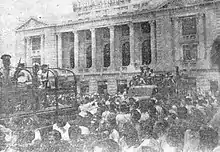Palm Sunday Coup
The Palm Sunday Coup was an attempted military coup d'état in El Salvador which occurred in April 1944. The coup was staged by pro-Axis sympathizers in the Salvadoran Army against President Maximiliano Hernández Martínez.
| Palm Sunday Coup | |||||||
|---|---|---|---|---|---|---|---|
| Part of World War II | |||||||
 Soldiers in San Salvador during the coup attempt. | |||||||
| |||||||
| Belligerents | |||||||
|
|
| ||||||
| Commanders and leaders | |||||||
|
|
| ||||||
| Units involved | |||||||
| Salvadoran Army |
First Infantry Regiment Second Artillery Regiment Salvadoran Air Force | ||||||
Background
Brigadier General Maximiliano Hernández Martínez became President of El Salvador following a military coup d'état on 2 December 1931 against President Arturo Araujo Fajardo.[1] During the lead up to World War II, Hernández Martínez heavily sympathized with Germany and Italy.[2] Despite his sympathies for the Axis, El Salvador joined the Allies on 8 December 1941 following the Attack on Pearl Harbor by Japan.[2][3][4]
Coup
Hernández Martínez held an election in January 1944 and was reelected to a third term as President.[5] His action angered many businessmen, politicians, and military officer since he blatantly violated the Constitution.[6]
On 2 April 1944, military officers who had pro-Axis sympathies from the 1st Infantry Regiment and the 2nd Artillery Regiment initiated a coup against Hernández Martínez.[6] The coup started on Palm Sunday and most senior military and government officials were either at home or attending church.[6][7] The rebels rose up in the departments of San Salvador and Santa Ana.[7] They took control of the national radio station and the police headquarters of Santa Ana during the coup.[7] The Salvadoran Air Force joined the conspirators and bombed the city of Santa Ana while the army attacked civilians and overthrew the local government.[7]
By the end of the day, Hernández Martínez ordered military units still loyal to him to crush the revolt.[7] The coup was suppressed on 3 April, martial law was declared, and a national curfew was put in place.[7]
Aftermath
Following the coup attempt, Hernández Martínez initiated reprisals that lasted for two weeks.[7] Civilian protestors eventually forced Hernández Martínez to resign on 9 May in the Strike of Fallen Arms.[7][8]
See also
References
- Grieb, Kenneth J. (1971). "The United States and the Rise of General Maximiliano Hernandez Martinez". Journal of Latin American Studies. 3 (2): 151–172. doi:10.1017/S0022216X00001425. JSTOR 156558.
- Haggerty 1990, p. 17
- Astilla 1976, p. 184
- Armstrong 1982, p. 34
- Nohlen, Dieter (2005). Elections in the Americas: A Data Handbook. 1. p. 287.
- Haggerty 1990, p. 18
- Zunes, Stephen (October 2010). "Movements and Campaigns - El Salvador: 1944". Nonviolent Conflict. Archived from the original on 31 December 2010. Retrieved 19 September 2020.
- Ackerman, Peter; DuVall, Jack (2015). A Force More Powerful: A Century of Non-violent Conflict. St. Martin's Press. pp. 256–263.
Bibliography
- Armstrong, Robert; Shenk, Janet (1982). El Salvador: The Face of Revolution. Boston: South End Press. ISBN 0896081389.
- Carmelo Francisco Esmeralda Astilla (1976). "The Martinez Era: Salvadoran-American Relations, 1931-1944". Louisiana State University and Agricultural & Mechanical College.
- Federal Research Division Library of Congress (1990). Haggerty, Richard A. (ed.). El Salvador: A Country Study (PDF). Washington, D.C.: The Library of Congress. Retrieved 17 September 2020.